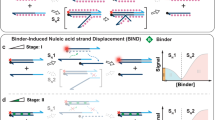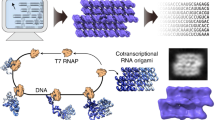Abstract
Spectacular progress has been made in the design of proteins that recognize double-stranded DNA with a chosen specificity, to the point that designer DNA-binding proteins can be ordered commercially. This success raises the question of whether it will be possible to engineer libraries of proteins that can recognize RNA with tailored specificity. Given the recent explosion in the number and diversity of RNA species demonstrated to play roles in biology, designer RNA-binding proteins are set to become valuable tools, both in the research laboratory and potentially in the clinic. Here we discuss the prospects for the realization of this idea.
This is a preview of subscription content, access via your institution
Access options
Subscribe to this journal
Receive 12 print issues and online access
$189.00 per year
only $15.75 per issue
Buy this article
- Purchase on Springer Link
- Instant access to full article PDF
Prices may be subject to local taxes which are calculated during checkout



Similar content being viewed by others
Change history
17 March 2011
In the version of this article initially published, in several instances "guanidine" should have read "guanine", "uridine" should have read "uracil" and "adenine" should have read "adenosine"; in two instances; "tetratrispolin" should have read "tristetraprolin"; and Figure 2c,d should have illustrated the structure from PDB record 1M8Y. These errors have been corrected in the HTML and PDF versions of the article.
References
García-Martinez, J., Aranda, A. & Pérez-Ortín, J.E. Genomic run-on evaluates transcription rates for all yeast genes and identifies gene regulatory mechanisms. Mol. Cell 15, 303–313 (2004).
Hieronymus, H. & Silver, P.A. Genome-wide analysis of RNA-protein interactions illustrates specificity of the mRNA export machinery. Nat. Genet. 33, 155–161 (2003).
Van Der Kelen, K., Beyaert, R., Inze, D. & De Veylder, L. Translational control of eukaryotic gene expression. Crit. Rev. Biochem. Mol. Biol. 44, 143–168 (2009).
Nilsen, T.W. & Graveley, B.R. Expansion of the eukaryotic proteome by alternative splicing. Nature 463, 457–463 (2010).
Mattick, J.S. & Makunin, I.V. Non-coding RNA. Hum. Mol. Genet. 15 Spec No 1, R17–R29 (2006).
Friedman, R.C., Farh, K.K., Burge, C.B. & Bartel, D.P. Most mammalian mRNAs are conserved targets of microRNAs. Genome Res. 19, 92–105 (2009).
Guttman, M. et al. Chromatin signature reveals over a thousand highly conserved large non-coding RNAs in mammals. Nature 458, 223–227 (2009).
Sera, T. Zinc-finger-based artificial transcription factors and their applications. Adv. Drug Deliv. Rev. 61, 513–526 (2009).
Cathomen, T. & Joung, J.K. Zinc-finger nucleases: the next generation emerges. Mol. Ther. 16, 1200–1207 (2008).
Carroll, D. Progress and prospects: Zinc-finger nucleases as gene therapy agents. Gene Ther. 15, 1463–1468 (2008).
Camenisch, T.D., Brilliant, M.H. & Segal, D.J. Critical parameters for genome editing using zinc finger nucleases. Mini Rev. Med. Chem. 8, 669–676 (2008).
Rebar, E.J. Development of pro-angiogenic engineered transcription factors for the treatment of cardiovascular disease. Expert Opin. Investig. Drugs 13, 829–839 (2004).
Liu, Q. & Paroo, Z. Biochemical principles of small RNA pathways. Annu. Rev. Biochem. 79, 295–319 (2010).
Perrimon, N., Ni, J.Q. & Perkins, L. In vivo RNAi: today and tomorrow. Cold Spring Harb. Perspect. Biol. 2, a003640 (2010).
Vaishnaw, A.K. et al. A status report on RNAi therapeutics. Silence 1, 14 (2010).
De Gregorio, E., Preiss, T. & Hentze, M.W. Translation driven by an eIF4G core domain in vivo. EMBO J. 18, 4865–4874 (1999).
Bertrand, E. et al. Localization of ASH1 mRNA particles in living yeast. Mol. Cell 2, 437–445 (1998).
Coller, J.M., Gray, N.K. & Wickens, M.P. mRNA stabilization by poly(A) binding protein is independent of poly(A) and requires translation. Genes Dev. 12, 3226–3235 (1998).
Auweter, S.D., Oberstrass, F.C. & Allain, F.H. Sequence-specific binding of single-stranded RNA: is there a code for recognition? Nucleic Acids Res. 34, 4943–4959 (2006).
Chen, Y. & Varani, G. Protein families and RNA recognition. FEBS J. 272, 2088–2097 (2005).
Cléry, A., Blatter, M. & Allain, F.H. RNA recognition motifs: boring? Not quite. Curr. Opin. Struct. Biol. 18, 290–298 (2008).
Dominguez, C., Fisette, J.F., Chabot, B. & Allain, F.H. Structural basis of G-tract recognition and encaging by hnRNP F quasi-RRMs. Nat. Struct. Mol. Biol. 17, 853–861 (2010).
Oubridge, C., Ito, N., Evans, P.R., Teo, C.H. & Nagai, K. Crystal structure at 1.92 Å resolution of the RNA-binding domain of the U1A spliceosomal protein complexed with an RNA hairpin. Nature 372, 432–438 (1994).
Laird-Offringa, I.A. & Belasco, J.G. Analysis of RNA-binding proteins by in vitro genetic selection: identification of an amino acid residue important for locking U1A onto its RNA target. Proc. Natl. Acad. Sci. USA 92, 11859–11863 (1995).
Chen, Y., Mandic, J. & Varani, G. Cell-free selection of RNA-binding proteins using in vitro compartmentalization. Nucleic Acids Res. 36, e128 (2008).
Auweter, S.D. et al. Molecular basis of RNA recognition by the human alternative splicing factor Fox-1. EMBO J. 25, 163–173 (2006).
Edwards, T.A., Pyle, S.E., Wharton, R.P. & Aggarwal, A.K. Structure of Pumilio reveals similarity between RNA and peptide binding motifs. Cell 105, 281–289 (2001).
Miller, M.T., Higgin, J.J. & Hall, T.M. Basis of altered RNA-binding specificity by PUF proteins revealed by crystal structures of yeast Puf4p. Nat. Struct. Mol. Biol. 15, 397–402 (2008).
Wang, X., McLachlan, J., Zamore, P.D. & Hall, T.M. Modular recognition of RNA by a human pumilio-homology domain. Cell 110, 501–512 (2002).
Wang, Y., Opperman, L., Wickens, M. & Hall, T.M. Structural basis for specific recognition of multiple mRNA targets by a PUF regulatory protein. Proc. Natl. Acad. Sci. USA 106, 20186–20191 (2009).
Boch, J. et al. Breaking the code of DNA binding specificity of TAL-type III effectors. Science 326, 1509–1512 (2009).
Moscou, M.J. & Bogdanove, A.J. A simple cipher governs DNA recognition by TAL effectors. Science 326, 1501 (2009).
Cheong, C.G. & Hall, T.M. Engineering RNA sequence specificity of Pumilio repeats. Proc. Natl. Acad. Sci. USA 103, 13635–13639 (2006).
Ozawa, T., Natori, Y., Sato, M. & Umezawa, Y. Imaging dynamics of endogenous mitochondrial RNA in single living cells. Nat. Methods 4, 413–419 (2007).
Tilsner, J. et al. Live-cell imaging of viral RNA genomes using a Pumilio-based reporter. Plant J. 57, 758–770 (2009).
Wang, Y., Cheong, C.G., Hall, T.M. & Wang, Z. Engineering splicing factors with designed specificities. Nat. Methods 6, 825–830 (2009).
Valverde, R., Edwards, L. & Regan, L. Structure and function of KH domains. FEBS J. 275, 2712–2726 (2008).
García-Mayoral, M.F. et al. The structure of the C-terminal KH domains of KSRP reveals a noncanonical motif important for mRNA degradation. Structure 15, 485–498 (2007).
Liu, Z. et al. Structural basis for recognition of the intron branch site RNA by splicing factor 1. Science 294, 1098–1102 (2001).
Beuth, B., Pennell, S., Arnvig, K.B., Martin, S.R. & Taylor, I.A. Structure of a Mycobacterium tuberculosis NusA-RNA complex. EMBO J. 24, 3576–3587 (2005).
Chmiel, N.H., Rio, D.C. & Doudna, J.A. Distinct contributions of KH domains to substrate binding affinity of Drosophila P-element somatic inhibitor protein. RNA 12, 283–291 (2006).
Braddock, D.T., Louis, J.M., Baber, J.L., Levens, D. & Clore, G.M. Structure and dynamics of KH domains from FBP bound to single-stranded DNA. Nature 415, 1051–1056 (2002).
Taylor, G.A. et al. A pathogenetic role for TNF alpha in the syndrome of cachexia, arthritis, and autoimmunity resulting from tristetraprolin (TTP) deficiency. Immunity 4, 445–454 (1996).
Hudson, B.P., Martinez-Yamout, M.A., Dyson, H.J. & Wright, P.E. Recognition of the mRNA AU-rich element by the zinc finger domain of TIS11d. Nat. Struct. Mol. Biol. 11, 257–264 (2004).
Pagano, J.M., Farley, B.M., McCoig, L.M. & Ryder, S.P. Molecular basis of RNA recognition by the embryonic polarity determinant MEX-5. J. Biol. Chem. 282, 8883–8894 (2007).
Lu, D., Searles, M.A. & Klug, A. Crystal structure of a zinc-finger-RNA complex reveals two modes of molecular recognition. Nature 426, 96–100 (2003).
De Guzman, R.N. et al. Structure of the HIV-1 nucleocapsid protein bound to the SL3 psi-RNA recognition element. Science 279, 384–388 (1998).
Dey, A., York, D., Smalls-Mantey, A. & Summers, M.F. Composition and sequence-dependent binding of RNA to the nucleocapsid protein of Moloney murine leukemia virus. Biochemistry 44, 3735–3744 (2005).
Morellet, N. et al. Structure of the complex between the HIV-1 nucleocapsid protein NCp7 and the single-stranded pentanucleotide d(ACGCC). J. Mol. Biol. 283, 419–434 (1998).
Guerrerio, A.L. & Berg, J.M. Design of single-stranded nucleic acid binding peptides based on nucleocapsid CCHC-box zinc-binding domains. J. Am. Chem. Soc. 132, 9638–9643 (2010).
Beddow, A.L., Richards, S.A., Orem, N.R. & Macara, I.G. The Ran/TC4 GTPase-binding domain: identification by expression cloning and characterization of a conserved sequence motif. Proc. Natl. Acad. Sci. USA 92, 3328–3332 (1995).
Higa, M.M., Alam, S.L., Sundquist, W.I. & Ullman, K.S. Molecular characterization of the Ran-binding zinc finger domain of Nup153. J. Biol. Chem. 282, 17090–17100 (2007).
Alam, S.L. et al. Ubiquitin interactions of NZF zinc fingers. EMBO J. 23, 1411–1421 (2004).
Loughlin, F.E. et al. The zinc fingers of the SR-like protein ZRANB2 are single-stranded RNA-binding domains that recognize 5′ splice site-like sequences. Proc. Natl. Acad. Sci. USA 106, 5581–5586 (2009).
Segal, D.J. & Barbas, C.F. III. Custom DNA-binding proteins come of age: polydactyl zinc-finger proteins. Curr. Opin. Biotechnol. 12, 632–637 (2001).
Isalan, M., Klug, A. & Choo, Y. A rapid, generally applicable method to engineer zinc fingers illustrated by targeting the HIV-1 promoter. Nat. Biotechnol. 19, 656–660 (2001).
Hargous, Y. et al. Molecular basis of RNA recognition and TAP binding by the SR proteins SRp20 and 9G8. EMBO J. 25, 5126–5137 (2006).
Sickmier, E.A. et al. Structural basis for polypyrimidine tract recognition by the essential pre-mRNA splicing factor U2AF65. Mol. Cell 23, 49–59 (2006).
Acknowledgements
This work was supported in part by a grant from the National Health and Medical Research Council of Australia to J.P.M.
Author information
Authors and Affiliations
Corresponding authors
Ethics declarations
Competing interests
The authors declare no competing financial interests.
Rights and permissions
About this article
Cite this article
Mackay, J., Font, J. & Segal, D. The prospects for designer single-stranded RNA-binding proteins. Nat Struct Mol Biol 18, 256–261 (2011). https://doi.org/10.1038/nsmb.2005
Published:
Issue Date:
DOI: https://doi.org/10.1038/nsmb.2005
This article is cited by
-
CRISPR/Cas13a targeting of RNA virus in plants
Plant Cell Reports (2018)
-
Targeted inhibition of oncogenic miR-21 maturation with designed RNA-binding proteins
Nature Chemical Biology (2016)
-
Modular assembly of designer PUF proteins for specific post-transcriptional regulation of endogenous RNA
Journal of Biological Engineering (2014)
-
Programmable RNA recognition and cleavage by CRISPR/Cas9
Nature (2014)
-
Synthetic oligonucleotides recruit ILF2/3 to RNA transcripts to modulate splicing
Nature Chemical Biology (2012)



